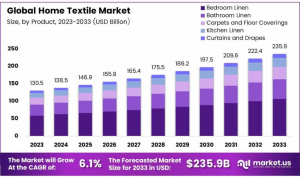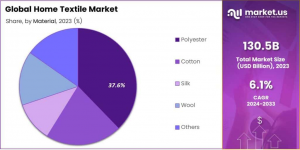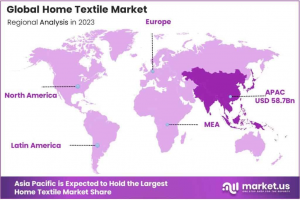Home Textile Market size is expected to be worth around USD 235.9 Billion by 2033, from USD 130.5 Billion in 2023, growing at a CAGR of 6.1%.
Asia Pacific holds 45.6% of the Home Textile Market, driven by strong manufacturing and a growing middle class in key markets like China and India.”
NEW YORK, NY, UNITED STATES, January 24, 2025 /EINPresswire.com/ -- Market Overview— Tajammul Pangarkar
The Global Home Textile Market size is expected to be worth around USD 235.9 Billion by 2033, from USD 130.5 Billion in 2023, growing at a CAGR of 6.1% during the forecast period from 2024 to 2033.
The Home Textile Market encompasses all textiles used in household purposes. These range from functional products like bed linens, towels, and kitchen textiles to decorative items such as curtains and upholstery fabrics. This market caters to the demands of consumers looking to enhance the aesthetic and comfort of their living spaces.
With over a decade of experience analyzing various markets, it's clear that the Home Textile Market is poised for significant growth. This sector thrives on the back of rising global income levels and the increasing consumer interest in home decor. The trend towards interior design enhancements in residential spaces continues to drive demand for high-quality and customized home textiles. Additionally, technological advancements in fabric production and eco-friendly materials are creating new opportunities for manufacturers.
Governments worldwide are also recognizing the importance of this sector and are investing in infrastructure that supports textile manufacturing, including subsidies for sustainable practices. Regulations are being strengthened to ensure that home textiles meet safety and environmental standards, encouraging manufacturers to innovate and comply with these updated policies.
The Home Textile Market offers abundant opportunities for both new and existing players. For new entrants, the current trend towards eco-friendly and technologically enhanced products opens up numerous market niches. For established players, there's potential to expand into new geographical areas, especially in emerging markets where the demand for home textiles is growing rapidly due to urbanization.
Investing in online retail channels is also a lucrative strategy, as e-commerce continues to soar in popularity. Additionally, companies that focus on creating personalized experiences for consumers, such as offering customizable textile options, can differentiate themselves from competitors and increase their market share. The ongoing innovation in smart textiles, incorporating functionalities such as connectivity and health monitoring, also presents a frontier for growth that companies can capitalize on to cater to the modern, health-conscious consumer.
These strategic focus areas, combined with an understanding of the evolving regulatory landscape and consumer preferences, can guide companies towards successful ventures and expansions in the Home Textile Market.
Curious About Market Trends? Request Your Complimentary Sample Report Today: https://market.us/report/home-textile-market/free-sample/
Key Takeaway
-The global home textile market is projected to grow from USD 130.5 billion in 2023 to USD 235.9 billion by 2033, at a CAGR of 6.1%.
-Bedroom linen leads the product segment with a 45.3% share in 2023, driven by demand for premium, eco-friendly materials.
-Polyester dominates the material segment, holding a 37.6% share in 2023, favored for its versatility and cost-efficiency.
-Offline distribution channels command a 65.5% market share in 2023, with supermarkets/hypermarkets playing a crucial role.
-Asia Pacific leads the regional market with a 45.6% share valued USD 58.7 billion, underpinned by strong manufacturing capabilities and a growing middle class in China and India.
Use Cases
• Home Décor: Home textiles like throw pillows, blankets, and tablecloths play an important role in interior design. Consumers use these products to refresh their homes, adding aesthetic appeal and comfort. Bright colors, patterns, and textures are regularly updated according to seasonal trends.
• Bedding and Mattresses: High-quality bedding, including sheets, comforters, and pillowcases, remains a staple of the home textile market. Consumers are looking for premium materials like organic cotton or silk for improved sleep comfort and quality.
• Sustainable Textiles: As eco-conscious living gains traction, there is a growing demand for sustainable home textiles. Organic fabrics, recycled materials, and eco-friendly dyes are becoming a selling point for consumers who prioritize environmental impact.
• Functional Fabrics for Home Use: Textiles that offer functional benefits, such as stain-resistant curtains, waterproof tablecloths, or thermal bedding, are in demand. These products combine practicality with style, offering consumers both aesthetics and convenience.
• Luxury Home Linens: The demand for luxury home textiles is increasing as affluent consumers look for premium, high-end products. Fine linens, soft towels, and custom-made curtains offer a sense of luxury and exclusivity, enhancing the comfort and style of living spaces.
Driving Factors
• Growing Interest in Home Décor: People are increasingly investing in home decoration, creating demand for textiles like curtains, rugs, and bedding. The rise in interior design trends has made home textiles an essential part of home aesthetics.
• Increasing Disposable Income: As income levels rise, people have more money to spend on non-essential items like premium home textiles. Consumers are willing to invest in quality textiles for better comfort and luxury.
• Urbanization: As more people move to urban areas, the demand for home textiles rises. Smaller living spaces often require functional and stylish textile solutions, such as multi-purpose bedding and space-saving curtains.
• Eco-Friendly Products: Consumers are increasingly seeking sustainable and eco-friendly home textile options. Organic fabrics and sustainable manufacturing processes are driving market growth in this segment.
• Seasonal Demand: Changes in seasons create a fluctuation in the demand for home textiles. For instance, demand for heavier blankets and bedding rises in the winter, while lighter fabrics and colors are preferred in summer.
Report Segmentation
In 2023, Bedroom Linen led the Home Textile Market's product segment with a 45.3% share, driven by growing demand for premium and eco-friendly materials. Polyester dominated the material segment with a 37.6% share, thanks to its versatility and cost-effectiveness. The offline distribution channel also held a strong position with 65.5% of the market, largely driven by supermarkets, hypermarkets, and specialty stores, which offer wide accessibility and cater to specific consumer preferences.
By Product
~Bedroom Linen
~Bathroom Linen
~Carpets and Floor Coverings
~Kitchen Linen
~Curtains and Drapes
By Material
~Polyester
~Cotton
~Silk
~Wool
~Others
By Distribution Channel
~Offline
~Supermarket/Hypermarket
~Specialty Stores
~Others
~Online
Ready to Act on Market Opportunities? Buy Your Report Now and Get 30% off: https://market.us/purchase-report/?report_id=135037
Regional Analysis
Asia Pacific dominates the home textile market with a 45.6% share, valued at USD 58.7 billion. The region’s leadership stems from its vast manufacturing capabilities and a rapidly growing middle class, especially in China and India. These countries are key players as both large producers and consumers, benefiting from cost-effective production and efficient supply chains.
Growth Opportunities
• Increasing Demand for Sustainable Fabrics As consumers become more environmentally conscious, there is a growing preference for eco-friendly materials such as organic cotton, bamboo, and hemp. Brands can capitalize on this trend by offering sustainable home textiles.
• Customization and Personalization Offering customized home textiles like personalized bed linens, towels, and curtains can appeal to consumers who want unique products. Customization options such as monogramming or choosing fabric and design allow brands to stand out.
• Rise in DIY Home Decor As more people take an interest in home improvement and interior decorating, there is an increasing demand for home textiles. Companies that offer a wide range of textiles for curtains, bedding, and tablecloths are well-positioned to benefit.
• Technological Advancements in Fabrics The development of innovative textiles, such as stain-resistant, temperature-regulating, and antibacterial fabrics, presents new opportunities. Incorporating these technologies into home textiles can cater to consumer demand for more functional and long-lasting products.
• Online Sales Growth E-commerce is increasingly becoming the preferred method of shopping for home textiles. With the ability to browse a wide selection from home and receive items quickly, online stores can reach a global audience, providing significant growth potential.
Key Players
~Welspun Group
~New Sega Home Textiles
~Ralph Lauren Corporation
~Trident Group
~Marvic Textiles
~Shanghai Hometex, Honsun
~Springs Global
~Shenzhen Fuanna
~Hunan Mendale Hometextile Company Ltd.
~LLC Honsun Home Textile
Not Sure? Request a Sample Report and See How Our Insights Can Drive Your Business: https://market.us/report/home-textile-market/free-sample/
Trending Factors
• Rise in Home Decor Interest: Increased interest in home décor and interior design, partly driven by social media, is boosting the demand for home textiles like curtains, bedding, and cushions.
• Eco-friendly Materials: There's a growing consumer preference for textiles made from organic and sustainable materials due to heightened environmental awareness.
• Technological Innovations: Advances in textile production technologies have led to the development of smarter, more durable home textiles that often come with added functionalities such as antibacterial properties and improved durability.
• Customization and Personalization: Consumers are looking for customized home textile options that match their personal style and décor, driving the demand for bespoke home textile products.
• Increase in Online Sales: The growth of e-commerce has made it easier for consumers to purchase home textiles online, broadening the market reach and offering a wider variety of products.
Restraining Factors
• Fluctuating Raw Material Prices: The prices of raw materials like cotton, polyester, and wool are highly volatile. When these prices rise, it can lead to higher production costs for home textiles, making it difficult for companies to maintain profitability without raising prices.
• Seasonal Demand Variations: Demand for home textiles, such as bedding, curtains, and rugs, fluctuates with seasons. For example, sales spike during holiday seasons and colder months but decline in warmer months. This seasonal pattern can lead to periods of low sales, making revenue less predictable.
• Intense Market Competition: The home textile market is highly fragmented, with numerous local and international players. Intense competition, especially from low-cost producers in emerging markets, can make it difficult for established brands to maintain market share without heavy investment in marketing.
• Consumer Sensitivity to Quality: While price plays a role, many consumers also prioritize high-quality, durable products. This means manufacturers face pressure to constantly improve the quality of textiles while managing costs. Balancing quality with affordability can be challenging.
• Sustainability Concerns: As consumers become more environmentally conscious, there is increasing demand for sustainable and eco-friendly textiles. Companies that do not adopt these practices may face a loss in market share as consumers turn toward brands with more sustainable options.
Conclusion
In conclusion, the Global Home Textile Market is projected to grow significantly, from USD 130.5 billion in 2023 to USD 235.9 billion by 2033, at a CAGR of 6.1%. This growth is fueled by rising disposable incomes, increasing interest in home décor, and the demand for sustainable and functional textiles. Emerging trends such as eco-friendly fabrics, personalization, and advancements in textile technology are reshaping the market landscape.
However, challenges like fluctuating raw material prices, seasonal demand variations, and intense competition may pose obstacles for market players. To capitalize on growth opportunities, companies should focus on sustainable practices, customization, innovative fabric technologies, and expanding their online presence to reach a broader consumer base. By aligning with evolving consumer preferences and leveraging digital channels, the home textile market presents ample opportunities for sustained growth and innovation.
Related Report
Gardening Pots Market: https://market.us/report/gardening-pots-market/
Deodorizer Bags Market: https://market.us/report/deodorizer-bags-market/
Seam Tapes Market: https://market.us/report/seam-tapes-market/
Stain Remover Products Market: https://market.us/report/stain-remover-products-market/
Minimalist Furniture Market: https://market.us/report/minimalist-furniture-market/
Lawrence John
Prudour
+91 91308 55334
Lawrence@prudour.com
Visit us on social media:
Facebook
LinkedIn
Legal Disclaimer:
EIN Presswire provides this news content "as is" without warranty of any kind. We do not accept any responsibility or liability for the accuracy, content, images, videos, licenses, completeness, legality, or reliability of the information contained in this article. If you have any complaints or copyright issues related to this article, kindly contact the author above.




